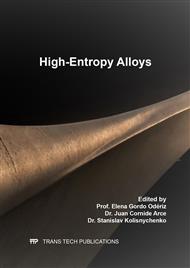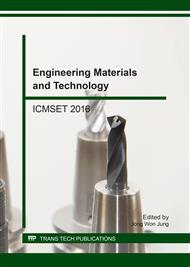[1]
J. W. Yeh, S. K. Chen, S. J. Lin, J. Y. Gan, T. S. Chin, Nanostructured High-Entropy Alloys with Multiple Principal Elements: Novel Alloy Design Concepts and Outcomes, Adv. Eng. Mater. 6 (2004) 299–303.
DOI: 10.1002/adem.200300567
Google Scholar
[2]
C. Y. Hsu, J. W. Yeh, S. K. Chen, T. T. Shun, Wear resistance and high-temperature compression strength of Fcc CuCoNiCrAl0. 5Fe alloy with boron addition, Metall. Mater. Trans. A 35 (2004) 1465–1469.
DOI: 10.1007/s11661-004-0254-x
Google Scholar
[3]
Y. Zhang, Y. J. Zhou, J. P. Lin, G. L. Chen, P. K. Liaw, Solid-Solution Phase Formation Rules for Multi-component Alloys, Adv. Eng. Mater. 10 (2008) 534–538.
DOI: 10.1002/adem.200700240
Google Scholar
[4]
Y. Zhang, T. T. Zuo, Z. Tang, M. C. Gao, K. A. Dahmen, Microstructures and properties of high-entropy alloys, Prog. Mater. Sci. 61 (2014) 1–93.
Google Scholar
[5]
G. Salishchev, M. Tikhonovsky, D. Shaysultanov, N. Stepanov, A. Kuznetsov, Effect of Mn and V on structure and mechanical properties of high-entropy alloys based on CoCrFeNi system, J. Alloy. Compd. 591 (2014) 11–21.
DOI: 10.1016/j.jallcom.2013.12.210
Google Scholar
[6]
B. S. Murty, J. W. Yeh, S. Ranganathan, High-Entropy Alloys, Elsevier Science (2014).
Google Scholar
[7]
S. I. Hong, J. Moon, S. K Hong, H. S. Kim, Mater. Sci. Eng. A., Thermally activated deformation and the rate controlling mechanism in CoCrFeMnNi high entropy alloy (2016) http: /dx. doi. org/10. 1016/j. msea. 2016. 11. 078.
DOI: 10.1016/j.msea.2016.11.078
Google Scholar
[8]
I. Toda-Caraballo, P. E. J. Rivera-Dı´az-del-Castillo, Modelling solid solution hardening in high entropy alloys, Acta Mater. 85 (2015) 14-23.
DOI: 10.1016/j.actamat.2014.11.014
Google Scholar
[9]
R. Labusch, G. Grange, J. Ahearn, P. Haasen, in: J. C. M. Li, A. K. Mukherjee (Eds. ), Deformation and Fracture of High Polymers, ASM, Cleveland, Ohio (1975) 26-46.
Google Scholar
[10]
S. I. Hong, Influence of dynamic strain aging on the stress exponent and the dislocation substructure for the creep of Al Mg alloys, Mater. Sci. Eng. 82 (1986) 175-185.
DOI: 10.1016/0025-5416(86)90105-9
Google Scholar
[11]
S. I. Hong, Influence of dynamic strain aging on the dislocation substructure in a uniaxial tension test, Mater. Sci. Eng. 79 (1) 1-7.
Google Scholar
[12]
S. I. Hong, Influence of dynamic strain aging on the transition of creep characteristics of a solid solution alloy at various temperatures, Mater. Sci. Eng. A. 110 (1989) 125-130.
DOI: 10.1016/0921-5093(89)90163-9
Google Scholar
[13]
K. L. Murty, F. A. Mohamed and J. E. Dorn, Acts Metar. 20 (1972) 1009.
Google Scholar
[14]
F. A. Mohamed, Creep behavior of solid solution alloys, Mater. Sci. Eng. 38 (1979) 73-80.
Google Scholar
[15]
P. Yavari, T. G. Langdon, An examination of the breakdown in creep by viscous glide in solid solution alloys at high stress levels, Acta Metall. 30 (1982) 2181-2196.
DOI: 10.1016/0001-6160(82)90139-0
Google Scholar
[16]
M. Pahutova, J. Cadek, On two types of creep behaviour of F.C.C. solid solution alloys, Phys. Stat. Sol. (a) 56 (1979) 305-313.
DOI: 10.1002/pssa.2210560133
Google Scholar
[17]
G. B. Jeong, I. W. Kim, S. I. Hong, Influence of microstructure modification on the circumferential creep of Zr–Nb–Sn–Fe cladding tubes, J. Nucl. Mater. 468 (2016) 171-177.
DOI: 10.1016/j.jnucmat.2015.11.029
Google Scholar
[18]
S. Y. Lee, K. T. Kim, S. I. Hong, Circumferential creep properties of stress-relieved Zircaloy-4 and Zr–Nb–Sn–Fe cladding tubes, J. Nucl. Mater. 392 (2009) 63-69.
DOI: 10.1016/j.jnucmat.2009.03.045
Google Scholar
[19]
S. I. Hong, Influence of dynamic strain aging on the apparent activation energy for creep, Mater. Sci. Eng. 64 (1984) L19-L21.
DOI: 10.1016/0025-5416(84)90112-5
Google Scholar
[20]
W. H. Liu, Y. Wu, J. Y. He, T. G. Nieh, Z. P. Lu, Grain growth and the Hall–Petch relationship in a high-entropy FeCrNiCoMn alloy, Scripta Materialia 68 (2013) 526–529.
DOI: 10.1016/j.scriptamat.2012.12.002
Google Scholar
[21]
K. Y. Tsai, M. H. Tsai, J. W. Yeh, Sluggish diffusion in Co–Cr–Fe–Mn–Ni high-entropy alloys, Acta Mater. 61 (2013) 4887–4897.
DOI: 10.1016/j.actamat.2013.04.058
Google Scholar



